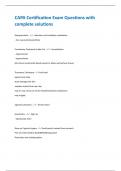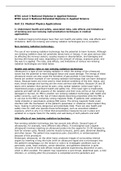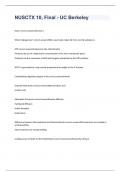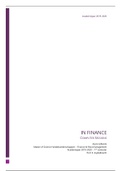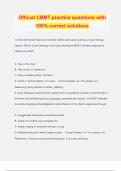Lecture 8 IR core
Security between states
What we are talking about…
The war between Ukraine and Russia is a very good example of why we should study IR.
Security – a fuzzy concept
• Latin sine cura: without worry, without concern
• Security as “a low probability of damage to acquired values” (Baldwin 1997: 485) → still
raises questions
Defining security:
• Whose security?
o States & state leaders (historical focus) → increasing focus on groups (e.g. Kurds
in Syria) & individuals (such as refugees)
• From which threats?
o War & conflict, hunger & poverty, being safe from diseases
• For which values?
o Political security, economic security
• Objective or subjective security?
o Objective secure: according to some parameters that we decide…
o or whether people feel subjectively secure
• How much security?
o Measuring on matters of degree…
o or secure/insecure
• By what means?
o What means should we take to provide security?
• At what cost?
o How much are we willing to pay for security?
o E.g. the war in Afghanistan fought by the US → after a long costly war, they
decided it is not worth the cost anymore
Defining war and conflict
• “War, to be abolished, must be understood. To be understood, it must be studied.”
(Deutsch, 1970: 473)
• What counts as a war?
o Need analytical definition
• Conceptual definition of war: “War is organized violence carried on by political units
against each other.” (Bull, 1983: 184)
o This allows us to rule out massacres, genocide, the Cold War, cyberwar
, • Operational definition (Correlates of War, UCDP data → see link pp)
o Intensity threshold: a lot of definitions use this → once a certain level of intensity
is reached, it is considered a war
o War > 1000 fatalities per year
o Armed conflict > 25 fatalities per year
Organized violence in the pre-modern era
A lot of debate about whether there was more violence in the pre-modern era or in the modern
era.
• Pre-modern: lots of violence; bible is full of violence, descriptions of the Middle-Era are
often full of violence
• Some historians and sociologists disagree: there might have been a lot of routine violence,
but massive violence/coercion before you had centralized states and armies people didn’t
have the capacity to perform such massive violence as we see in the modern times
• Modern: states have more constraint on violence, but if they decide to use violence it is
much more massive
War since 1816, incidence
➢ Biggest issue with the data: when we
look at data for war and conflict we
have much better data for Western
countries than for non-Western
countries
➢ At most 25 per year at the global level
→ graph shows frequencies, not intensity
➢ Some decrease of interstate war
➢ Issue: figure overstates the incidents of war in more recent times, because the number of
states has increased
Wars and conflict since 1945, incidence
➢ Incidents of interstate war seem to be declining
Battle deaths in war since 1816
➢ The world wars were much more lethal and deadly than any
other wars historically
➢ Issue: the population has increased massively → z.o.z. for graph
and adjusted graph
,Militarized disputes between states, incidence
➢ Threats, displays or uses of force
➢ Russian troop movements in 2021 is
considered as a threat of force
Why is (interstate) war declining?
(Mid-level) realist answers:
• Fearon (1995) and solutions to problems of information, commitment, and issue
indivisibility (mentioned before) → addressing these issues could reduce the risk of
conflict
o Strategy applied: peacekeeping (will be a separate lecture about)
• The declining intensity of the security dilemma (Schelling 1960; Posen 1993)
o The security dilemma needs to be less intense, for there to be less conflict.
Security dilemma:
Posen applies the security dilemma to the question of ethnic conflict after multinational empires
collapse
• What is the security dilemma?
o Defensive actions seen as offensive by others → arms race, escalation, or war
o Classic example: arms races during the Cold War → e.g. Cuban Missile Crisis
o Other example: someone in America buys a gun, someone else then feels the need
to also buy a gun and Europeans look at this and think “everyone now is less safe”
• Security dilemma is mostly thought of involving two actors
• Offense-defense balance explains intensity of security dilemma
o Offense-defense balance: if it is an offense balance then there is more security
dilemma, with defense balance there is less of a security dilemma
o Function of geography, military technology, or strength of group identity that
determine the intensity of a security dilemma
o Posen: the strength of group identity is an important part for whether a balance is
more offensive or defensive and whether we see more or less of a security
dilemma
▪ Geography: Germany is surrounded by land, so they would probably be
offensive, while GB and the US can have a more defensive attitude,
because they are surrounded by water
, ▪ Military technology: a tank is an offensive type of military technology,
anti-tank weapons are a defensive type
▪ Group identity: Posen: mainly from the perspective of ethnic groups → a
strong ethnic group identity can lead to ingroup/outgroup dynamics → you
have a strong bond with and a lot of cohesion in the ingroup → at the same
time that goes hand-in-hand with hostile relations with the outgroup → can
lead to conflict → so the stronger ethnic group identity the more offensive
the balance is → because you can use that identity in war to have a strong
unity
The ethnic security dilemma (Posen):
• Combining the idea of strong identity leading to an offensive balance with the idea of
geography → “ethnic islands” favor the offense: when we have a situation where the
ethnic groups have a strong identity, but are also geographically isolated (like surrounded
by other ethnic groups) → dangerous situations because it can lead to offensive behavior
from the surrounding ethnic groups because the ethnic island has such a strong identity, or
people who are in the ethnic island they might engage in preventive violence = main
claim
• For example: Azerbaijan and Armenia who fought several conflicts and
wars against each other, including in 2020 about this enclave of Nagorno-
Karabakh → fits this description
o Ethnic Armenians are surrounded by Azerbaijanis
• He also uses the case of the collapse of Yugoslavia, Croatia, Servia, but
also Bosnian Muslims in this enclave were targeted by Serbs because they
were in a vulnerable position.
• Problems main claim: role of fear, segregation as a result of conflict, and unclear on
origins of group identity
o Role of fear: where does this interpretation come from? Were does the idea come
from that actions that were taken defensively are interpreted offensively? Seems
that there must be some pre-existing fear or anxiety for that to play out → realism
on its own CANNOT explain this, they would have to turn to psychology for it
o Segregation as a result of conflict: having these enclaves is also often the result of
fighting → so it is a consequence of conflict, rather than a cause
o Unclear origins of group identity: with states it is plausible to have some kind of
national identity, but with groups you can ask yourself why do they consider
themselves as groups? Why do those groups exist as a unit in the first place? → in
realism this information is totally left out
o He also mentions that the risk of conflict between Russia and Ukraine is lower →
he was wrong about that → he wrote this in 1993 and Ukraine gave up their
nuclear weapons in 1994

